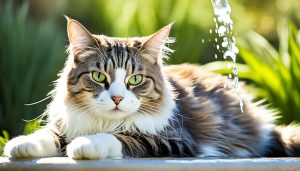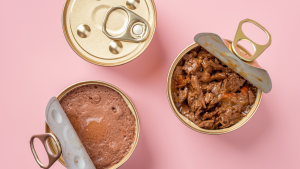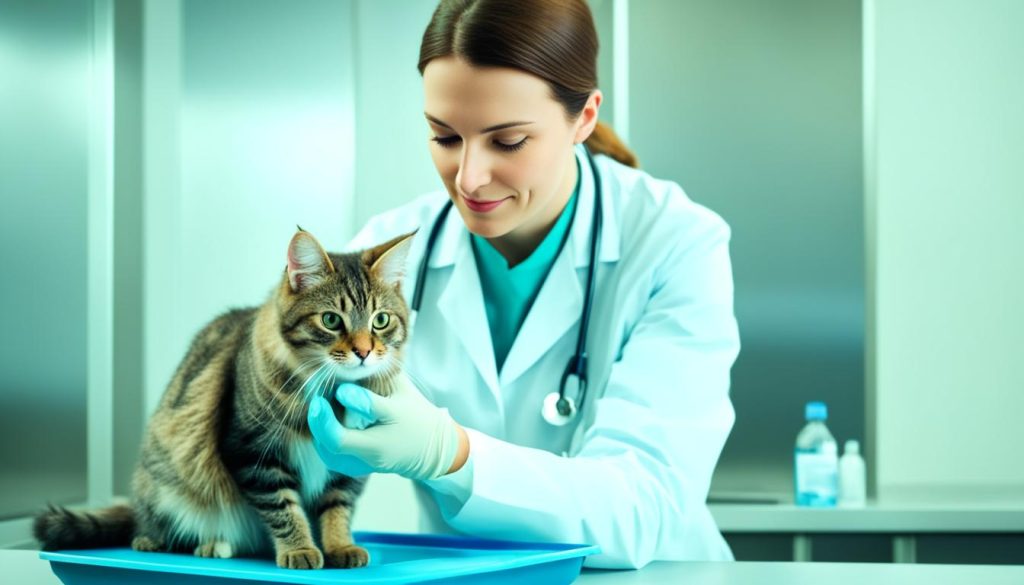Maintaining proper hydration is crucial for a cat’s health and well-being. Dehydration can lead to serious medical issues, including organ failure, heat stroke, and even death. As responsible pet owners, we must ensure our feline companions have access to fresh, clean water at all times. In this comprehensive guide, we’ll explore effective strategies to keep your cat hydrated, from calculating their daily water needs to incorporating creative methods to encourage water intake.

Key Points
- Dehydration in cats is a serious medical condition that can lead to life-threatening complications.
- Calculating your cat’s daily water needs is essential to ensuring adequate hydration.
- Providing fresh, clean water bowls and using creative methods to encourage water intake can help keep your cat hydrated.
- Recognizing the signs of dehydration, such as dry gums and lethargy, is crucial for timely veterinary intervention.
- Maintaining your cat’s hydration is a vital responsibility for their overall health and well-being.
Dehydration in Cats: A Serious Medical Issue
Pet healthcare and animal health are crucial aspects of responsible cat ownership. One prevalent issue that cat owners must be aware of is the risk of dehydration. Dehydration in cats is a serious medical concern that can have severe consequences if left untreated.
Causes and Consequences of Dehydration
Cats can become dehydrated for various reasons, including a lack of interest in drinking water, vomiting, diarrhea, heat stroke, diabetes, and kidney disease. Dehydration can lead to various health problems, such as organ dysfunction, electrolyte imbalances, and even organ failure if not addressed promptly.
Identifying the Signs of Dehydration
Recognizing the signs of dehydration in cats is essential for ensuring prompt medical attention and treatment. Some common signs of dehydration in cats include:
- Dry gums
- Decreased skin elasticity
- Lethargy
- Loss of appetite
- Sunken eyes
- Decreased urination
If you notice these signs in your cat, it is crucial to seek veterinary assistance immediately to prevent further complications and ensure your cat’s well-being.
By understanding the causes and consequences of dehydration in cats, as well as recognizing the early signs, pet owners can take proactive steps to maintain their cat’s animal health and ensure they receive the necessary veterinary services to address this pet healthcare concern.
Calculating Your Cat’s Daily Water Needs
Maintaining proper pet nutrition and cat health is crucial for ensuring your feline friend’s overall well-being. One key aspect of this is ensuring your cat stays adequately hydrated throughout the day. But how do you determine your cat’s daily water needs?
As a general rule, the average healthy cat requires approximately 1 ounce of water per pound of body weight every day. So, for example, an 8-pound cat would need around 8 ounces (1 cup) of water daily to stay properly hydrated.
However, this water intake can vary depending on several factors, including:
- Activity level – More active cats may require additional water to replace what they lose through increased physical activity.
- Environmental temperature – Cats living in warmer climates or environments may need more water to maintain proper hydration.
- Diet – Cats eating primarily canned pet food tend to require less additional water intake, as canned food contains a higher moisture content compared to dry kibble.
To ensure your feline friend is getting the right amount of water each day, it’s a good idea to monitor their intake and adjust as needed based on their individual needs and circumstances. By staying vigilant about animal care, you can help keep your cat happy, healthy, and properly hydrated.
Providing Fresh, Clean Water Bowls
Ensuring your feline friend always has access to fresh, clean pet supplies is one of the simplest yet most important steps in keeping them hydrated. Experts recommend a straightforward routine to maintain your cat’s water bowls in pristine condition.
Tips for Keeping Water Bowls Clean
To provide your cat with an appealing and healthy water source, follow these easy tips for clean water bowls:
- Dump the entire water bowl daily and wipe out any slime or buildup.
- Refill the bowl with fresh, cool water to encourage drinking.
- Wash the bowl thoroughly with soap and warm water at least once a week.
- Avoid allowing water to sit for prolonged periods, as this can lead to bacteria growth.
- Consider using pet accessories like raised feeders or non-slip mats to keep the area tidy.
Regular cleaning of your cat’s water bowls is crucial to maintaining a sanitary and inviting water source. By following these simple steps, you can ensure your feline friend has access to the fresh, clean water they need to stay hydrated and healthy.
Keeping your cat’s pet grooming essentials and water bowls clean is an easy way to support their overall well-being. Invest a few minutes each day to provide your furry companion with the fresh, clean water they deserve.
Encouraging Water Intake with Creative Methods
Cats are naturally curious creatures, and pet owners can leverage this trait to encourage increased water intake. By offering water in different types of containers and locations throughout the home, you can pique your feline’s interest and motivate them to stay hydrated.
Using Different Containers and Locations
Placing a glass of water on the coffee table or a bowl in a new spot in the house can stimulate your cat’s pet behavior and encourage them to explore and investigate the new water source. This element of discovery and animal enrichment can make the drinking experience more engaging and enticing for your furry friend.
Incorporating Broth or Ice Cubes
Another way to make water more appealing to your cat is by adding a small amount of low-fat, low-sodium broth or freezing broth into ice cubes. The savory flavor and cool temperature can make the water more tempting, leading to increased pet accessories consumption and better hydration.
By incorporating these creative methods, you can play to your cat’s natural curiosity and preferences, ensuring they stay properly hydrated and healthy.
The Benefits of Pets Water Fountains
When it comes to ensuring your feline friend stays hydrated, pet water fountains can be a game-changer. These innovative pet accessories provide a constant supply of clean, circulating water that often appeals to cats more than a traditional water bowl.
One of the primary advantages of pet water fountains is their ability to encourage increased water intake. Cats are naturally drawn to running water, and the continuous flow of these fountains can entice them to drink more throughout the day. Adequate hydration is crucial for animal health, as it supports various bodily functions and can help prevent issues like urinary tract infections and kidney problems.
In addition, pet water fountains typically feature built-in filtration systems that remove impurities and keep the water fresh. This can be especially beneficial for cats who may turn their noses up at stagnant water in a bowl. By providing a steady supply of clean, filtered water, these fountains can help promote better overall pet health and hydration.
Another advantage of pet water fountains is their convenience. Unlike traditional water bowls, which require frequent refilling and cleaning, these fountains are designed to be low-maintenance. Many models feature large reservoirs that can hold enough water to last for days, reducing the need for constant monitoring and refilling.
When selecting a pet water fountain, it’s important to choose a model that is appropriately sized for your cat’s needs. Factors like the fountain’s capacity, flow rate, and noise level can all impact its suitability and your cat’s willingness to use it. Consulting with your veterinarian or researching customer reviews can help ensure you find the best fit for your feline friend.
By incorporating a pet water fountain into your cat’s environment, you can help ensure your furry companion stays hydrated and healthy. These innovative pet accessories can be a valuable addition to any cat owner’s arsenal for maintaining their pet’s animal health and well-being.
Increasing Hydration with Canned Cat Food
One of the easiest ways to ensure your feline friend stays hydrated is by offering canned pet nutrition. Canned cat food has a significantly higher water content compared to dry kibble, and most cats find the moist, meaty texture and flavor irresistible. By incorporating canned food into your cat’s health routine, you can effortlessly boost your pet’s daily water intake.
The higher moisture content in canned cat food can be particularly beneficial for cats prone to dehydration or those with certain medical conditions. Canned food not only satisfies your cat’s thirst but also provides essential nutrients and animal care requirements.
To further enhance your cat’s hydration, you can even add a small amount of freshwater or diluted broth to the canned food. This simple step can encourage your cat to consume even more liquid, keeping them well-hydrated and healthy.
When transitioning your cat to a canned food diet, be sure to do so gradually to allow their digestive system to adjust. Sudden changes in diet can sometimes lead to gastrointestinal upset, so patience and persistence are key.

Remember, proper pet nutrition and hydration are crucial for your cat’s overall well-being. By incorporating canned food as part of their balanced diet, you can help ensure your feline friend stays happy, healthy, and well-hydrated.
Signs Your Cat May Be Dehydrated
Ensuring your feline friend remains properly hydrated is crucial for their overall pet healthcare and well-being. However, recognizing the signs of dehydration in cats can be challenging, as they often develop gradually. By understanding the common indicators of dehydration, pet owners can take proactive steps to address the issue and provide the necessary animal health support.
Dry Gums and Lack of Skin Elasticity
One of the primary signs of dehydration in cats is dry, sticky gums. To check for this, gently press on your cat’s gums, and if the color takes a few seconds to return, it may be a sign of dehydration. Additionally, a lack of skin elasticity is another telltale sign. Gently pinch the skin on your cat’s neck and release it – if the skin remains tented rather than snapping back into place, it could indicate dehydration.
Lethargy and Decreased Urination
Dehydration can also lead to lethargy and decreased urination in cats. If your feline friend seems more lethargic than usual, with little interest in play or exploration, it may be a sign that they are not getting enough fluids. Similarly, a decrease in the frequency or volume of urination can be a concerning indicator of dehydration that requires veterinary services’ attention.
If you notice any of these signs in your cat, it is essential to act promptly and seek guidance from a veterinary professional. Dehydration can quickly lead to serious health complications, and early intervention is key to ensuring your beloved pet’s well-being.
Seeking Veterinary Assistance for Dehydration
If your cat exhibits signs of dehydration, seeking prompt veterinary care is crucial. Your cat’s veterinarian will conduct a thorough examination and run necessary diagnostic tests to identify the underlying cause of the dehydration and provide the appropriate medical treatment. Neglecting to address dehydration can lead to serious secondary health issues, making it essential to address the problem swiftly with the guidance of a veterinary professional.
During the veterinary visit, the vet will assess your cat’s hydration status through various methods, such as evaluating skin elasticity, gum moisture, and capillary refill time. They may also recommend additional tests, like bloodwork or urinalysis, to determine the root cause of the dehydration, which could range from underlying medical conditions to dietary factors or medication side effects.
Based on the findings, the veterinarian will develop a personalized treatment plan to restore your cat’s fluid balance and address the underlying issue. This may involve administering intravenous (IV) fluids, adjusting the cat’s diet, or prescribing medications to address any underlying medical conditions. The vet will also guide how to maintain your cat’s hydration at home during the recovery process.
Addressing dehydration promptly through veterinary services is crucial for your cat’s pet healthcare and overall animal health. By working closely with your cat’s veterinarian, you can ensure your feline friend receives the necessary treatment and support to regain optimal hydration levels and prevent any long-term complications.
| Veterinary Assistance for Dehydration | Key Considerations |
|---|---|
| Prompt Examination and Diagnosis | The veterinarian will assess hydration status and identify underlying causes |
| Personalized Treatment Plan | IV fluids, dietary adjustments, and/or medication as needed |
| Ongoing Monitoring and Guidance | Ensure proper hydration during recovery and prevent future dehydration |

By seeking timely veterinary services for dehydration, you can help ensure your cat’s pet healthcare and animal health are maintained, leading to a healthier, happier feline companion.
Keeping Your Cat Hydrated: A Vital Responsibility
As a responsible pet owner, ensuring your feline friend stays well-hydrated is a crucial aspect of pet care and animal welfare. Proper hydration is essential for your cat’s overall health and well-being, and neglecting this vital need can lead to serious medical issues. By taking proactive steps to keep your cat hydrated, you can help them thrive and enjoy a happy, healthy life.
One of the most important things you can do as a pet owner is to provide your cat with fresh, clean water at all times. This means regularly refreshing their water bowls and keeping them free of debris or contaminants. Additionally, you can encourage your cat’s water intake by using different containers or adding ice cubes or low-sodium broth to their water.
Another effective way to maintain your cat’s hydration is by incorporating canned cat food into their diet. Canned food typically has a higher moisture content compared to dry kibble, which can help increase your cat’s overall water consumption.
It’s also crucial to be attentive to the signs of dehydration in your cat, such as dry gums, lack of skin elasticity, and decreased urination. If you notice these symptoms, it’s important to seek veterinary assistance promptly to address the issue and prevent further complications.
Keeping your cat hydrated is a vital responsibility that requires diligence and vigilance. By providing fresh water, encouraging water intake, and recognizing the signs of dehydration, you can help ensure your feline friend remains healthy and happy. Prioritizing your cat’s hydration needs is an essential aspect of responsible pet ownership and animal welfare.
| Hydration Benefits for Cats | Consequences of Dehydration |
|---|---|
|
|
Conclusion
Keeping your cat hydrated is a vital responsibility for every pet owner. By understanding the importance of proper hydration and implementing effective strategies, you can ensure your feline companion remains healthy, happy, and vibrant. From calculating their daily water needs to providing clean and accessible water sources, the steps outlined in this article empower you to proactively address the issue of dehydration in cats.
Whether you choose to utilize creative methods like water fountains or canned food to encourage water intake, or simply maintain clean and fresh water bowls, your efforts will go a long way in promoting your cat’s overall pet care, animal health, and pet ownership. Remember to be vigilant in monitoring for signs of dehydration and seek veterinary assistance if any concerns arise.
Ultimately, keeping your cat hydrated is a testament to your commitment as a responsible pet owner. By prioritizing this essential aspect of your cat’s well-being, you can contribute to their longevity, comfort, and overall quality of life. Embrace the strategies presented here and embark on a journey of optimal animal health for your feline companion.